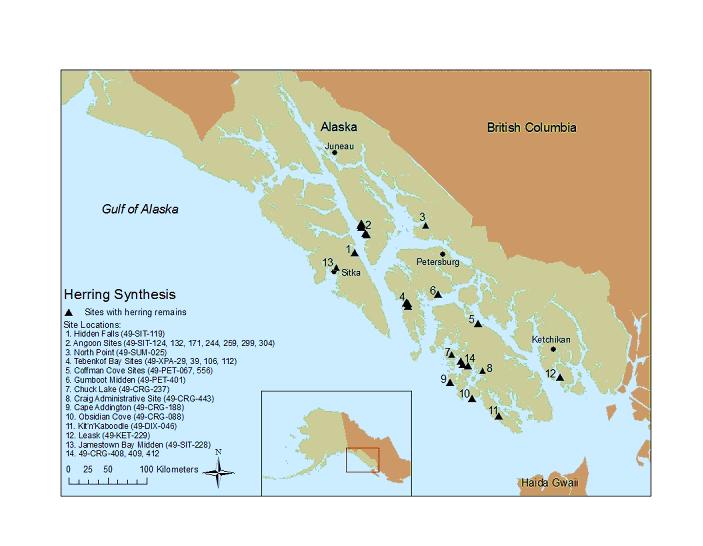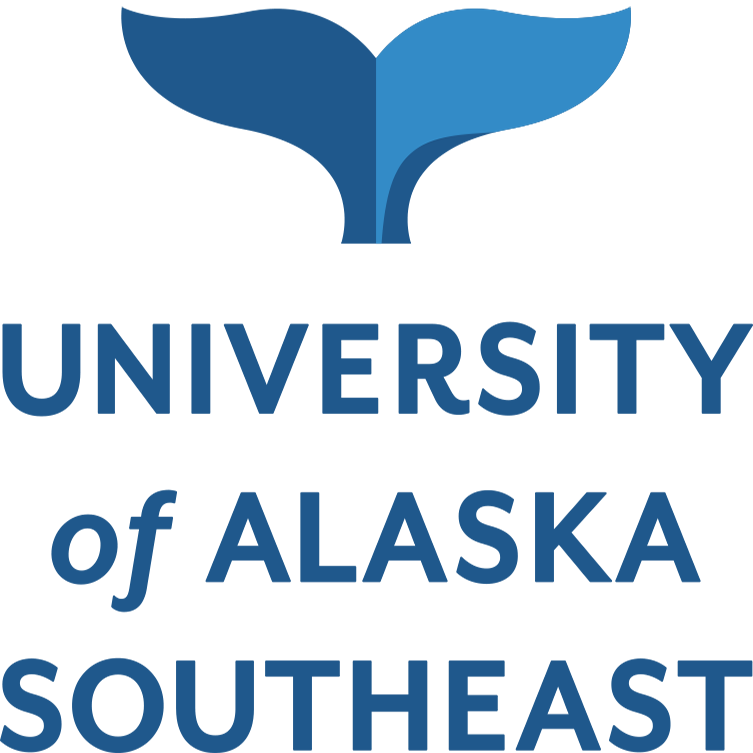
The Role of Zooarchaeology in the Herring Synthesis Project
Our role in the Herring Synthesis Project has been to study past herring distribution and abundance using zooarchaeology. Our work has three main parts. In the first phase, we have created a database summarizing our current knowledge of zooarchaeological records from Southeast Alaska. Taxonomic information for herring and other vertebrate and invertebrate fauna has been compiled from all existing archaeological site reports including Forest Service and contract reports that are not widely distributed. We have targeted sites that received some sub-surface testing—from shovel probes to substantial excavation. All of the faunal data is included to provide estimates of relative abundance. Direct measurement of absolute prehistoric animal population levels using zooarchaeology is difficult; our approach is to examine trends by comparing herring abundance relative to other taxa. Reviewing the entire faunal record should allow us to consider ways the Tlingit, Haida, and their ancestors relied on broader food webs and how these strategies may have varied over time and space. The database we have developed lists the published and unpublished site reports, excavation methods, including screen size, volume excavated, condition and age estimate from radiocarbon or other methods, and site location. Importantly, excavation methods, particularly screen size used to recover bones and teeth, affect measures of taxonomic abundance. Given their small size, herring remains are especially prone to loss and are numerically underrepresented unless fine mesh sieving and laboratory analysis of bulk samples are undertaken. As part of our analysis, we consider variation in analytic decisions and
sampling approaches across the site records to insure comparability. We have identified 26 sites with herring remains, and for each, we present a site summary, organized by contemporary communities from which Local and Traditional Knowledge (LTK) information was obtained. This organization should facilitate integration of the archaeological, historical, and contemporary data on herring in the future.
The second phase of the project involved close analysis of faunal records to identify temporal and spatial trends in herring relative to other fish. The final part of the project incorporates the archaeological herring records (site location and other attributes, such as age, site function, other animal bone records) into the Herring Synthesis GIS which is being developed concurrently based on LTK, and historic catch
and herring resource records. This final integration phase of the project is still in development..
Herring Bones in Archaeological Sites - Challenges to Recovery
The main challenge to archaeological recovery of herring bones is that herring are small-bodied fish. In Southeast Alaska, adult herring can reach a length of 38 cm (15 in.; O’Clair and O’Clair 1998:343), but most herring are smaller, usually less than 30 cm long (Hay et al. 2000:420). The jaws (dentaries and premaxillae) lack teeth, but the vomer does have fine teeth. Herring cranial and pectoral bones are light and thin, and typically fragment into small pieces. Exceptions are the prootic and pterotic, which are quite robust and distinctive and can be found in abundance in archaeological deposits. The most numerous elements in any fish are the vertebrae, rays, and spines. Rays and spines are generally not diagnostic to species, however, so the herring vertebra is the most abundant and readily identified element. While the haemal and neural spines usually break off, vertebral centra are often found intact (Figure 4.1). The number of vertebrae in a herring varies by geographic region, but ranges from 46 to 55 per individual (Lassuy 1989).
The individual skeletal elements of the species are quite small; of course when fragmented, they become smaller still. Both whole and fragmentary bones can fall through the screens archaeologists use while excavating if the mesh size is too large. Although herring bones can be recovered by sharp-eyed screeners using ¼ inch mesh, this is not routine and most herring bones will fall through screens with openings this size; in fact, even 1/8 inch mesh screens are not adequate for recovery for herring remains. Based on comparison of fish bone recovery at the Namu site (ElSx-1) on the northern coast of British Columbia, Cannon (2000:728) asserts that “the vast majority of
herring vertebrae would easily pass through 1/8 inch mesh screen.” In the history of Southeast Alaskan archaeology, early excavations (and into the 1980s; Rachel Myron, 2009, pers. comm.) were done without any screening of site sediments, so that if herring bones are not reported, it does not mean that they were not present. The same statement is true of any excavation that has not used screens at least as fine as 1/8 inch. Most excavations, even in the 21st century, employ ¼ inch screens even though these are inadequate for herring bone recovery. To compensate for this, some of us take bulk samples (typically two liters or more) in which a specified volume of the archaeological deposit is recovered in its entirety, and then this material is sorted and analyzed in the laboratory under controlled conditions. Such bulk samples then provide a more adequate indication of herring abundance
Zooarchaeological Records of Herring in Southeast Alaska
As of March, 2009, 2846 archaeological sites are recorded in Southeast Alaska (McCallum 2009).10 We have reviewed 66 excavation reports; 22 were published in peer review journals, theses, dissertations, or monographs, and 44 were from less accessible
contract and Forest Service reports. Based on these reports, we found that 181 sites have undergone some subsurface testing or excavation; most of these are shell midden sites where the shell helps preserve bone. We believe that 181 tested sites is a minimum number; we know that Forest Service employees have tested more sites than this over the years, but that these have not always been reported in formats accessible to us. Of these 181 sites, faunal remains were recovered from 93 sites.
Of these 93 sites, 29 could not be included in any quantitative analysis of spatial and temporal trends for various reasons: mesh size and other recovery methods were not presented or incompletely reported; faunal identifications were incomplete (either determined by admission of analyst or inferred from the extremely narrow range of taxa identified when combined with limited information on analytic methods); and inability to assign to time period, given absence of radiocarbon or other dating method. A total of 64 sites were reported and described in sufficient detail for us to potentially use in quantitative analysis (see table below).
Community |
Number of Sites |
Site Name (AHRS No) |
Ketchikan/Saxman |
1 |
Leask (KET-229) |
Hydaburg/Craig/Klawock |
8 |
Obsidian Cove (CRG-088), Cape Addington (CRG-188), Chuck Lake (CRG-237), CRG-408, 409, 412, Craig Administrative Site (CRG-443), Kit’n’Kaboodle (DIX-046) |
Wrangell/Petersburg |
3 |
Coffman Cove Site (PET-067), Gumboot Midden (PET-401), Coffman Cove Ferry Terminal (PET-556) |
Kake |
4 |
Elena Bay (XPA-029), Step Island (XPA-039), XPA-106, 112 |
Angoon |
8 |
Hidden Falls (SIT-119), Killisnoo Picnicground (SIT-124), Yaay Shanoow (SIT-132), Marten’s Fort (SIT-171), Daax Haat Kanadaa (SIT-244), Keishish Aani (SIT-259), Anteyuq (SIT-299), Garnes Point (SIT-304) |
Sitka |
1 |
Jamestown Bay (SIT-228) |
Juneau/Douglas |
1 |
North Point (SUM-025) |
Hoonah |
0 |
|
Klukwan |
0 |
|
Yakutat |
0 |
|
There were 28 sites at which 1/8 inch or finer mesh screens were used producing results we judge as reliable for quantitative analyses of herring representation based on the comparative collections employed and/or analyst expertise. Of this subset of 28 sites, 21 (75%) contained herring bones (see map below), which indicates that when adequate recovery methods are used, the archaeological record shows widespread use of herring in the past. Five other sites yielded herring bones despite the methods used (49-CRG-237, 49-CRG-408, 49-CRG-409, 49-CRG-412, 49-CRG-443); these are also included in the map below for a total of 26 sites with herring.

Of the 26 sites with herring bones, 13 sites contained in excess of 50 herring remains. Seven of the 26 sites were studied as part of Moss’s (1989a) dissertation research on Admiralty Island where 2 mm mesh screens were used to analyze bulk samples. All but one of the sites excavated in that study produced herring bones. Another seven sites are sites Moss has been involved in excavating and analyzing at some point, and all included at least some fine mesh screening. To reiterate, if fine mesh screens are used, herring bones will likely be found.
Summary
Our project is the first attempt to synthesize all the faunal records from Southeast Alaska. Our present effort is more descriptive than explanatory, given various factors that we were unable to control for. We found numerous gaps in the record across both time and space. Although Chuck Lake (49-CRG-237) demonstrates that the use of herring has an antiquity going back to 9310-7930 cal BP, this is the only record of herring until about 4500 cal BP. The temporal gap between ~8000 and ~4500 cal BP reflects the scarcity of archaeological sites from this time period, not necessarily the absence of herring. After 4500 cal BP, the number of tested sites increases, but as mentioned earlier, few fish assemblages are more recent than 500 cal BP. The temporal gap between the most recent archaeological sites and the historic period might indicate de-population due to epidemic disease or movements of surviving groups. It may also reflect the archaeological practice of dating early, but not the most recent occupation levels at sites, assuming continuity with the historic period (Moss 2004b:182). Furthermore, as archaeologists, we have sometimes assumed that the historic period is better known ethnographically than it could be through study of the archaeological record, missing the opportunity to see how archaeology can inform our understanding of how broad patterns are played out on the ground in distinctive geographic and cultural settings.
Similarly, the spatial patterning we see mainly reflects location of archaeological projects, rather than something distinctive about past herring distribution or human use patterns. Relatively few archaeological investigations have occurred within the territories of the Yakutat, Chilkat, Chilkoot, and Huna kwáan territories located in the northern part of Southeast Alaska. Likewise, very few sites have been tested with methods adequate to recover herring in Sitka, Auk, and Taku kwáan territories. Another general trend is that more sites have been tested on the islands of the Alexander Archipelago than the mainland of Southeast Alaska.
Temporal trends can only be evaluated in three specific areas: around Angoon, at Coffman Cove, and in Tebenkof Bay. No temporal shifts were observed in the relatively recent sites around Angoon. At Coffman Cove, an earlier focus on salmon prior to 3000 cal BP gives way to heavier use of herring and cod after 3000 cal BP. In Tebenkof Bay, cod decline in abundance after 2700 cal BP, herring after 1000 cal BP, whereas salmon increase in abundance. These localized trends are not easily explained at this time. What is clear, however, is that there is no evidence for region-wide trends in fisheries in Southeast Alaska. This is partly due to limitations in the archaeological record, but nevertheless, at this time, faunal trends cannot be correlated with broader environmental or sociocultural changes.




